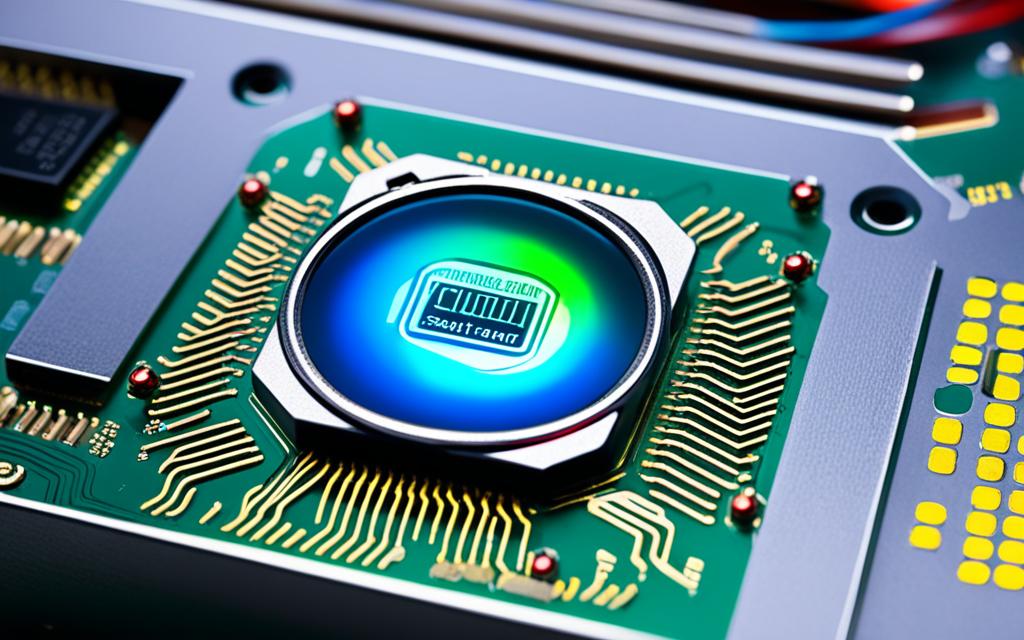Table of Contents
It’s crucial to know your CPU temperature limits if you need your computer to perform well. Overheating can cause big troubles, like making your computer slow or even damaging it. Being aware of the safe temperature for CPU is key. Usually, a CPU should be around 30-40 degrees Celsius when not doing much. But when it’s working hard, keeping it between 70-80 degrees Celsius is best. Going over 80 degrees Celsius could lead to problems, including throttling, which is a sign your CPU might fail soon.
CPU danger zones start when the temperature hits 81 degrees Celsius. Beyond this point, the chances of harm go up, with too much heat possibly causing permanent damage. Staying ahead by keeping an eye on your CPU’s temperature and doing routine check-ups helps keep risks low. For tips on how to check your CPU’s temperature, you can look at this helpful guide.
Key Takeaways
- Normal CPU temperatures range from 30-40 degrees Celsius.
- During heavy workloads, keep CPU temperatures between 70-80 degrees Celsius.
- Temperatures exceeding 80 degrees Celsius indicate potential overheating concerns.
- Critical temperatures above 81 degrees Celsius can lead to severe damage.
- Regular maintenance and monitoring are crucial to avoid CPU overheating.
- Utilising third-party software can provide accurate temperature readings.
Understanding CPU Temperature Basics
The performance of a CPU depends a lot on its temperature. Typically, CPUs run well at 30°C (86°F) to 70°C (158°F) for regular tasks. For intense tasks, they can reach 70°C to 95°C (158°F to 203°F)1. It’s important to keep the CPU at about 55 to 60 degrees Celsius for best results2.
Room temperature is key for good CPU performance. If the room is between 20°C and 27°C (68°F to 80°F), your CPU will likely run cooler and more efficiently3. Good room conditions help manage heat better, preventing problems caused by too much heat.
It’s crucial to understand how CPU temperature and workload are linked. Normally, CPUs work well between 40°C and 80°C (104°F and 176°F). Under heavy work, temperatures can go between 60°C and 90°C (140°F and 194°F)3. Tools like HWMonitor, Core Temp, and SpeedFan offer real-time views of CPU temperature.
Keeping your CPU cool requires regular upkeep. Clearing out dust, improving airflow, and maybe getting better cooling systems are great ways to help. These actions keep your CPU working well and for longer1.
| Operating Conditions | Typical CPU Temperature Range |
|---|---|
| Idle | 30-40°C |
| Light Load | 40-60°C |
| Gaming | 60-85°C |
| Intensive Tasks | 70-95°C |
How Is Heat Generated by Your CPU?
Your CPU gets hot because it uses electricity to do tasks. This process is natural. When the CPU works hard, like when gaming, it faces electrical resistance. This creates heat. CPUs today have so many transistors packed tightly together. This makes them get even hotter4. To deal with this heat, your computer uses cool tech. This includes metal parts and fans to move the heat away4.
Making your CPU work faster than intended can make it even hotter. This is called overclocking. It needs better ways to cool down to avoid damage. Not just the CPU, but other parts like hard drives also add to the heat. So, a good cooling plan is essential4.
To keep your CPU cool, make sure it has enough air. Also, using thermal paste helps. But if there’s too much dust, your computer won’t cool properly. That can make it run poorly and shorten its life4. You can also try making it run slower on purpose or use energy-saving features. Both can help reduce heat. Combining these methods helps keep your system running well5.
| Cooling Methods | Description |
|---|---|
| Air Cooling | Utilises fans and heat sinks for airflow and dissipation of heat. |
| Liquid Cooling | Employs a liquid coolant to absorb and transfer heat away from the CPU. |
| Passive Cooling | Relies on heat sinks alone without active airflow, suitable for low-power CPUs. |
| Phase Change Cooling | Involves cooling methods similar to refrigerators, allowing for extreme temperature drops. |
Knowing how and why your CPU heats up helps you keep it cool. This ensures it stays efficient during heavy use.
Using monitoring tools lets you see how the CPU’s work impacts its heat and energy use. This information helps you adjust things to keep your computer performing well6.
What Temperature Should Your CPU Be?
Keeping your CPU at the right temperature is crucial for it to work well and last long. Most CPUs work best when they’re between 40°C and 60°C. This range helps them run smoothly without getting too hot7. During heavy use, like gaming or using big software, the temperature can go up to 70°C to 80°C8.
If the temperature goes over 80°C, it’s time to worry about overheating8. To avoid damage, most CPUs slow down when they get too hot7. Even though some new CPUs can handle up to 100°C for a short time, it’s not good to keep them that hot for long7.
You should look at your CPU’s manual to find out the safest temperatures for it. Monitoring your CPU’s temperature can help you understand how it reacts under stress. It’s smart to use special software or check the BIOS settings to keep an eye on how hot it gets. This ensures it stays stable when it’s working hard during intense use.
How Hot Does a CPU Get Before It’s Dangerous?
Knowing how hot a CPU gets is key to keeping your computer in top shape. If a CPU stays hotter than 80°C (176°F), it might slow down or even get damaged permanently. The safe heat range is usually between 65°C to 85°C (149°F to 185°F) for heavy use. Intel says a CPU at 100°C is OK, but under 85°C is best for everyday.
Recognising Critical Temperature Thresholds
Spotting when a CPU gets too hot is important. Too much heat can slow down your computer a lot. Things like the type of CPU, the computer’s design, and how well air moves around it affect how hot it gets. Laptops often run cooler than desktops, which helps avoid too much heat9. Using tools like Core Temp for Windows and iStat Menus for Mac helps keep an eye on temperatures10.
Impact of Extended High Temperatures
Being too hot for too long is bad for a CPU’s health. Sometimes, after many years, a CPU might stop working well because of too much heat or sudden increases in power9. Keeping your computer clean, adjusting how fast fans run, and putting the CPU cooler back properly can help cool it down. People agree that doing things like reducing the CPU’s voltage can make it cooler by up to 10 degrees9. It’s good to take steps early to keep your CPU cool and working well.
Signs Your CPU Might Be Overheating
Knowing when your CPU is too hot is key to keeping your computer running well. A slow system might mean it’s overheating. This usually happens if it gets hotter than 80°C when working hard. Going over this temperature could mean trouble11. Computers might turn off suddenly if they get between 70°C to 100°C. This depends on who made your computer12.
If your computer’s fans are loud, that’s a warning sign. They’re working hard to cool down a hot CPU. Overheating can cause your computer to freeze or show the dreaded Blue Screen of Death. It’s really important to check how hot your computer parts are. This helps you catch problems early, especially in laptops with not much airflow12.
Too much heat can cause errors and glitches. It might mess up video games or make the whole system unstable. An overheating computer can also make your room warmer. Since it gives off a lot of heat, it can make your electricity bill go up12.
You should use programs like HWMonitor, Core Temp, and SpeedFan to watch your CPU’s temperature. Regularly cleaning dust and checking thermal paste can stop overheating. You should not wait to fix overheating. If you do, your computer might break down12. Learn how to handle CPU overheating and maintain your system’s health.
How to Check CPU Temperature
Learning to track your CPU temperature is key for keeping it running well. You can start with the system BIOS for a basic check. This gives you a quick view of your CPU temperature when the computer turns on.
For those wanting an easier way, many choose temperature monitoring apps. Core Temp and HWMonitor are popular and free. They let you watch your CPU temperature as it happens, along with other important info like voltages13. AMD’s Ryzen Master and Intel’s Extreme Tuning Utility give more detailed data for their users. They show info on each core and how to stop the CPU from getting too hot14.
Not everyone likes using software for this. You can also use an infrared thermometer to check the CPU cooler or case. This method does not interfere and is great for those who want to keep things simple. It works best when you know the good temperature range, which is usually between 40°C to 80°C13.
Here’s a summary of CPU temperature monitoring methods and what they offer:
| Method | Type | Key Features |
|---|---|---|
| BIOS | Built-in Tool | Basic temperature readings, no installation required |
| Core Temp | Software | Real-time CPU temperature readings, free to use |
| HWMonitor | Software | Comprehensive monitoring of temperatures and voltages |
| AMD Ryzen Master | Software | Detailed performance metrics for AMD processors |
| Intel XTU | Software | Monitoring and tuning for Intel processors |
| Infrared Thermometer | Hardware Tool | Non-intrusive temperature readings from the casing |
Keeping an eye on your CPU temperature is smart. It helps catch problems early. Using these methods, you can keep your CPU in good shape.
Methods to Maintain a Safe CPU Temperature
Keeping your CPU at the right temperature is key for its longevity and smooth performance. There are various ways to make sure it does not get too hot. First, ensure your PC case has good ventilation. Clear airflow helps a lot to stop overheating. This usually happens when dust collects or vents get blocked.
Using cooling fans is also a smart choice. A good air cooler, like a 240mm AIO liquid cooler, is often enough. Yet, sometimes, a bigger cooler such as the BE QUIET PURE ROCK 2 is better for keeping cool. This is instead of pricier options like the CORSAIR H100x WATERCOOLER15. A CPU might hit a high of 100°C when under lots of stress; taking care is important.
Regularly checking your computer, especially if it’s old or during the summer, is crucial. Thermal paste, which helps with heat, usually lasts about three years before it needs replacing16. Watching your CPU’s temperature with different apps can quickly tell you if it’s too hot.
Not running too many heavy apps at once can also reduce heat. Many find that their CPU works better and lasts longer with these steps17. Being proactive about keeping your CPU cool means you can use your device worry-free, without heat damage.
Conclusion
Keeping your CPU temperature in check is crucial for your computer’s long life and best performance. It’s important to keep it within 60-80 degrees Celsius to prevent overheating. Overheating can harm your computer’s parts18. Even though Intel CPUs work up to 100°C, staying too hot for too long can hurt their work and cause damage19. Normally, CPUs should be between 30°C and 40°C. This can go up to 75°C to 80°C when doing heavy tasks, like playing games20.
By keeping an eye on your CPU and taking steps to stop overheating, you can lower the chance of it slowing down or getting permanently damaged. This makes your computer work well for many years. To do this, keep your computer clean, make sure it has enough air flow, and use the right cooling methods.
Being proactive is the key to this. Knowing your CPU’s limits and spotting overheating signs early can help you adjust how you use it. This is essential for better performance and longer life for your computer parts20. Following these steps not only protects your investment but also improves energy use, making your computing experience better.
FAQ
What are the safe temperature limits for a CPU?
CPUs work best from 30°C (86°F) to 70°C (158°F). Always check your CPU’s guide for its safe range.
Can ambient room temperature affect CPU performance?
Yes, room temperature, best kept between 20°C and 27°C, can impact how well a CPU performs. A cooler room helps the CPU run more efficiently.
What causes a CPU to overheat?
Overheating can come from heavy usage, pushing the CPU too hard, and not enough air flow. Excess work creates heat from the CPU’s electrical energy.
How can I tell if my CPU is running too hot?
If your CPU is too hot, you might notice slow performance, unexpected shutdowns, loud fans, and system freezes. Keeping an eye on temperatures is key.
What are the methods to check my CPU temperature?
Check your CPU temperature in the BIOS, with software like Core Temp, or using infrared thermometers. Understanding these temperatures helps you look after your CPU’s health.
What can I do to prevent my CPU from overheating?
Prevent overheating with good airflow, cooling fans, keeping it clean, and using quality thermal paste. Regular checks, especially in hot weather, are wise.
What are the consequences of prolonged high CPU temperatures?
Long-term high CPU temperatures above 80°C (176°F) can harm performance and the CPU itself. Watching these temperatures is crucial for your CPU’s well-being.
Source Links
- https://computercity.com/hardware/processors/normal-cpu-temperatures – Normal CPU Temperatures: Guidelines for Safe & Optimal Performance – ComputerCity
- https://www.xda-developers.com/how-hot-too-hot-cpu/ – How hot is too hot for a CPU: Understanding the operating temperature of your processor
- https://www.linkedin.com/advice/3/what-normal-optimal-ranges-cpu-temperature-different – What are the normal and optimal ranges of CPU temperature for different types of processors?
- https://centralvalleycomputerparts.com/articles/why-do-cpus-get-hot/ – Why do CPU’s get hot?
- https://stackoverflow.com/questions/58644945/why-does-the-cpu-get-hotter-when-performing-heavier-calculations-compared-to-be – Why does the CPU get hotter when performing heavier calculations, compared to being idle?
- https://stackoverflow.com/questions/14631786/estimating-the-heat-generated-by-a-process-or-job – Estimating the heat generated by a process or job
- https://community.spiceworks.com/t/what-is-a-normal-temperature-for-a-cpu-and-how-do-i-keep-it-low/948818 – What is a normal temperature for a CPU and how do I keep it low?
- https://www.avast.com/c-how-to-check-cpu-temperature – How to Check and Monitor Your CPU Temperature
- https://www.overclock.net/threads/is-it-safe-to-squeeze-100°c-on-a-cpu-like-alder-lake.1798561/ – Is it safe to squeeze 100°C on a CPU like Alder Lake?
- https://www.pcmag.com/how-to/how-to-monitor-your-cpu-temperature – cpu temperature monitor
- https://www.linkedin.com/advice/0/what-common-causes-symptoms-cpu-overheating-skills-computer-repair – What are the common causes and symptoms of CPU overheating?
- https://techvilleonline.com/is-your-computer-overheating-6-signs-it-is-and-how-to-fix-it/ – Is Your Computer Overheating?: 6 Signs It is And How to Fix It
- https://www.wikihow.com/Monitor-CPU-Temperature – How to Monitor Your CPU Temperature: 4 Easy Tools
- https://www.digitaltrends.com/computing/how-to-check-your-cpu-temperature/ – How to check your CPU temperature | Digital Trends
- https://forums.tomshardware.com/threads/how-do-i-get-my-cpu-temps-down.3792940/ – Question – How do i get my CPU temps down ?
- https://www.pandasecurity.com/en/mediacenter/how-to-check-cpu-temp/ – How to Check Your CPU Temperature – Panda Security
- https://www.crucial.com/support/system-maintenance-cooling – How to cool down your PC or Laptop
- https://softwareg.com.au/blogs/computer-hardware/how-much-heat-can-a-cpu-take – How Much Heat Can A CPU Take
- https://www.pugetsystems.com/labs/articles/impact-of-temperature-on-intel-cpu-performance-606/ – Impact of Temperature on Intel CPU Performance
- https://www.shiksha.com/online-courses/articles/all-about-cpu-temperature-range/ – CPU Temperature Range That Must Be Maintained – Shiksha Online








